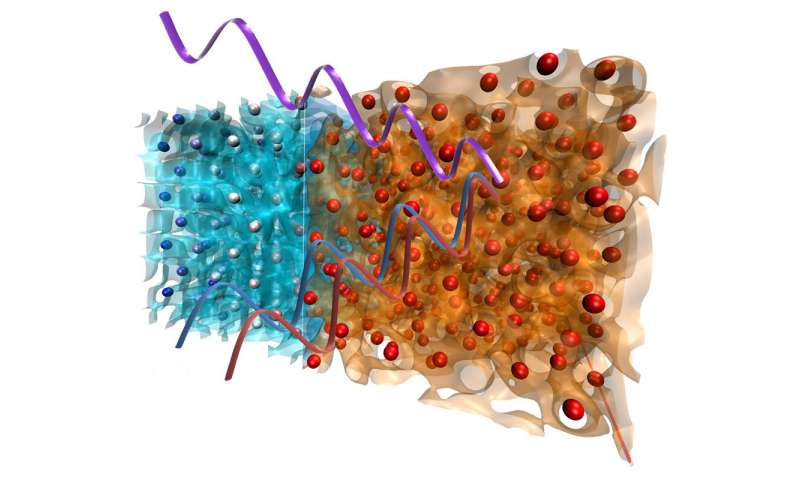Collective quantum effect: When electrons keep together
by Luise Träger
Many celestial objects such as stars or planets contain matter that is exposed to high temperatures and pressure—experts call it warm dense matter (WDM). Although this state of matter on earth only occurs in the earth's core, research on WDM is fundamental for various future areas such as clean energy, harder materials or a better understanding of solar systems. In a study recently published in Physical Review Letters, a team led by physicist Dr. Tobias Dornheim of the Center for Advanced Systems Understanding (CASUS) at Helmholtz Center Dresden-Rossendorf (HZDR) and alumnus of Kiel University (CAU), now reveals that warm dense matter behaves significantly differently than assumed, which calls into question its previous description.
To study the exotic state of warm dense matter on earth, scientists create it artificially in laboratories. This can be realized by compression through powerful lasers for example at the European XFEL in Schenefeld near Hamburg. "A sample, such as a plastic or aluminum foil, is illuminated with a laser beam, it heats up very strongly and is then compressed by a generated shock wave. The resulting spectra—that means how the sample behaves under these conditions—is recorded on detectors and in a scope of 10-10 m (1 angstrom) we can determine its material properties," explains Dr. Jan Vorberger from HZDR, adding: "However, important parameters such as temperature or density cannot be measured directly. Therefore, theoretical models are of central importance for the evaluation of the WDM experiments."
System reacts weaker the more it is perturbed
Tobias Dornheim develops such simulation models for the theoretical description of warm dense matter. From what scientists knew until now, calculations have been based exclusively on the assumption of a "linear reaction." That means, the more the samples—so called targets—are hit by laser irradiation, thus the more strongly the electrons are excited in these materials, the more strongly they react. In their new publication, however, Dr. Tobias Dornheim of CASUS, Dr. Jan Vorberger of HZDR and Prof. Dr. Michael Bonitz of CAU now show that under strong excitation the reaction is weaker than expected. They conclude that it is crucial to take into account nonlinear effects. The results have far-reaching implications for the interpretation of experiments with warm dense matter. "With this study we have laid the foundation for many new developments in the warm dense matter theory," Dornheim estimates, "and a lot of research on the nonlinear electronic density response of WDM will be done within the next years."
Their results are based on extensive computer simulations using the quantum statistical path-integral Monte Carlo method (PIMC). Richard Feynman laid the foundations of the method back in the 1950s. In recent years, Dr. Dornheim has successfully improved the algorithms to make calculations more efficient and faster. Nevertheless, for the mentioned study, supercomputers calculated on more than 10,000 CPU cores for more than 400 days. The calculations were carried out at the high performance clusters Hypnos and Hemera of the HZDR, the Taurus cluster at the Center for Information Services and High Performance Computing (ZIH) of the Technical University of Dresden, computers at the North German Association for High Performance Computing (HLRN) and at the computer center of the CAU.
WDM could play an important role for the energy industry
Research on warm dense matter is not only important for understanding the structure of planets such as Jupiter and Saturn or our solar system and its evolution, but is also applied in materials science, for example in the development of super-hard materials. However, it could play the most important role in the energy industry by contributing to the realization of inertial fusion—an almost inexhaustible and clean energy source with future potential.
More information: Tobias Dornheim et al. Nonlinear Electronic Density Response in Warm Dense Matter, Physical Review Letters (2020). DOI: 10.1103/PhysRevLett.125.085001
Journal information: Physical Review Letters
Provided by Kiel University